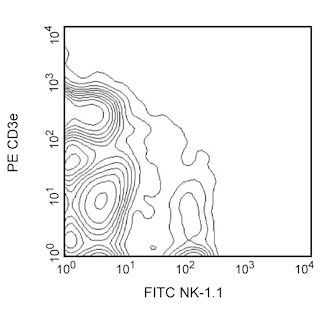Old Browser
Looks like you're visiting us from {countryName}.
Would you like to stay on the current country site or be switched to your country?


.png)

Multicolor flow cytometric analysis of KLRG1 expression on mouse splenocytes. C57BL/6 splenocytes were preincubated with Purified Rat Anti-Mouse CD16/CD32 (Mouse BD Fc Block™) (Cat. No. 553141/553142) and then stained with a FITC Mouse Anti-Mouse NK-1.1 antibody (Cat. No. 553164/561082) and either a PE Hamster IgG2, κ Isotype Control (Cat. No. 550085, Left Panel) or a PE Hamster Anti-Mouse KLRG1 antibody (Cat. No. 561621, Right Panel). Two-color flow cytometric dot plots showing the expressed levels of KLRG1 (or Ig isotype control staining) versus NK-1.1 were derived from gated events with the forward and side light-scatter characteristics of viable splenocytes. Flow cytometry was performed using a BD™ LSR II Flow Cytometer System.
.png)

BD Pharmingen™ PE Hamster Anti-Mouse KLRG1
.png)
Regulatory Status Legend
Any use of products other than the permitted use without the express written authorization of Becton, Dickinson and Company is strictly prohibited.
Preparation And Storage
Product Notices
- Since applications vary, each investigator should titrate the reagent to obtain optimal results.
- An isotype control should be used at the same concentration as the antibody of interest.
- Please refer to www.bdbiosciences.com/us/s/resources for technical protocols.
- Caution: Sodium azide yields highly toxic hydrazoic acid under acidic conditions. Dilute azide compounds in running water before discarding to avoid accumulation of potentially explosive deposits in plumbing.
- For fluorochrome spectra and suitable instrument settings, please refer to our Multicolor Flow Cytometry web page at www.bdbiosciences.com/colors.
- Although hamster immunoglobulin isotypes have not been well defined, BD Biosciences Pharmingen has grouped Armenian and Syrian hamster IgG monoclonal antibodies according to their reactivity with a panel of mouse anti-hamster IgG mAbs. A table of the hamster IgG groups, Reactivity of Mouse Anti-Hamster Ig mAbs, may be viewed at http://www.bdbiosciences.com/documents/hamster_chart_11x17.pdf.
Companion Products



.png?imwidth=320)


The 2F1 monoclonal antibody specifically binds to KLRG1 (Killer cell Lectin-like Receptor G1), which is the mouse homolog of the rat mast cell function-associated antigen (MAFA), on all mouse strains tested (eg, AKR/J, BALB/c, C3H/HeN, C3H.SW, C57BL/6, DBA/1, SJL, 129/J). Unlike rat MAFA, which is expressed on mast cells, mouse KLRG1 is expressed on a large subset of NK cells, lymphokine-activated killer (LAK) cells, adherent LAK (A-LAK) cells, subsets of activated CD8+ T lymphocytes, and small fractions of CD4+ and CD8+ T cells, but not mast cells. The expression of KLRG1 is correlated with reduced proliferative capacity of activated T lymphocytes or reduced effector functions of activated NK cells. KLRG1 plays a role in the regulation of leucocytes of both the innate and adaptive immune system. The 2F1 mAb reportedly stains the rat basophilic leukemia cell line, RBL-2H3, which is known to express MAFA. The KLRG1 protein is an inhibitory lectin-like type II transmembrane receptor containing a cytoplasmic motif similar to ITIM (Immunoreceptor Tyrosine-based Inhibitory Motif); its ligand has not been identified KLRG1 is expressed mainly as a homodimeric molecule consisting of two N-glycosylated subunits of approximately 30-38 kDa. The level of KLRG1 expression is reduced in MHC class I-deficient mice, although direct binding of KLRG1 to MHC class I antigens could not be detected. Crosslinking of KLRG1 by 2F1 mAb reduces TCR-mediated Ca++ mobilization and cytotoxic responses (but not IFN-γ production) by CD8+ T cells and inhibits IFN-γ and TNF production and redirected lysis by NK cells.

Development References (8)
-
Beyersdorf NB, Ding X, Karp K, Hanke T. Expression of inhibitory "killer cell lectin-like receptor G1" identifies unique subpopulations of effector and memory CD8 T cells. Eur J Immunol. 2001; 31(12):3443-3452. (Biology). View Reference
-
Blaser C, Kaufmann M, Pircher H. Virus-activated CD8 T cells and lymphokine-activated NK cells express the mast cell function-associated antigen, an inhibitory C-type lectin. J Immunol. 1998; 161(12):6451-6454. (Biology). View Reference
-
Corral L, Hanke T, Vance RE, Cado D, Raulet DH. NK cell expression of the killer cell lectin-like receptor G1 (KLRG1), the mouse homolog of MAFA, is modulated by MHC class I molecules. Eur J Immunol. 2000; 30(3):920-930. (Immunogen). View Reference
-
Hanke T, Corral L, Vance RE, Raulet DH. 2F1 antigen, the mouse homolog of the rat "mast cell function-associated antigen", is a lectin-like type II transmembrane receptor expressed by natural killer cells. Eur J Immunol. 1998; 28(12):4409-4417. (Biology). View Reference
-
McMahon CW, Zajac AJ, Jamieson AM. Viral and bacterial infections induce expression of multiple NK cell receptors in responding CD8(+) T cells. J Immunol. 2002; 169(3):1444-1452. (Biology). View Reference
-
Robbins SH, Nguyen KB, Takahashi N, Mikayama T, Biron CA, Brossay L. Cutting edge: inhibitory functions of the killer cell lectin-like receptor G1 molecule during the activation of mouse NK cells. J Immunol. 2002; 168(6):2585-2589. (Biology). View Reference
-
Robbins SH, Terrizzi SC, Sydora BC, Mikayama T, Brossay L. Differential regulation of killer cell lectin-like receptor G1 expression on T cells. J Immunol. 2003; 170(12):5876-5885. (Clone-specific: (Co)-stimulation, Stimulation). View Reference
-
Voehringer D, Blaser C, Brawand P, Raulet DH, Hanke T, Pircher H. Viral infections induce abundant numbers of senescent CD8 T cells. J Immunol. 2001; 167(9):4838-4843. (Biology). View Reference
Please refer to Support Documents for Quality Certificates
Global - Refer to manufacturer's instructions for use and related User Manuals and Technical data sheets before using this products as described
Comparisons, where applicable, are made against older BD Technology, manual methods or are general performance claims. Comparisons are not made against non-BD technologies, unless otherwise noted.
For Research Use Only. Not for use in diagnostic or therapeutic procedures.
Report a Site Issue
This form is intended to help us improve our website experience. For other support, please visit our Contact Us page.